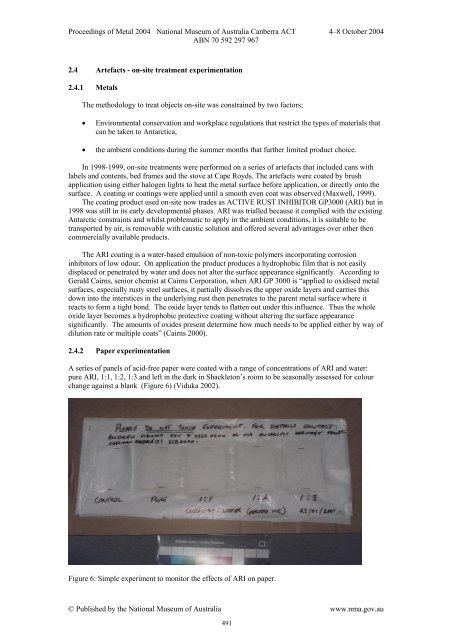Section 4: Composite artefacts (PDF 20858kb) - National Museum of ...
Section 4: Composite artefacts (PDF 20858kb) - National Museum of ...
Section 4: Composite artefacts (PDF 20858kb) - National Museum of ...
- No tags were found...
You also want an ePaper? Increase the reach of your titles
YUMPU automatically turns print PDFs into web optimized ePapers that Google loves.
Proceedings <strong>of</strong> Metal 2004 <strong>National</strong> <strong>Museum</strong> <strong>of</strong> Australia Canberra ACT 4–8 October 2004ABN 70 592 297 9672.4 Artefacts - on-site treatment experimentation2.4.1 MetalsThe methodology to treat objects on-site was constrained by two factors;• Environmental conservation and workplace regulations that restrict the types <strong>of</strong> materials thatcan be taken to Antarctica,• the ambient conditions during the summer months that further limited product choice.In 1998-1999, on-site treatments were performed on a series <strong>of</strong> <strong>artefacts</strong> that included cans withlabels and contents, bed frames and the stove at Cape Royds. The <strong>artefacts</strong> were coated by brushapplication using either halogen lights to heat the metal surface before application, or directly onto thesurface. A coating or coatings were applied until a smooth even coat was observed (Maxwell, 1999).The coating product used on-site now trades as ACTIVE RUST INHIBITOR GP3000 (ARI) but in1998 was still in its early developmental phases. ARI was trialled because it complied with the existingAntarctic constraints and whilst problematic to apply in the ambient conditions, it is suitable to betransported by air, is removable with caustic solution and <strong>of</strong>fered several advantages over other thencommercially available products.The ARI coating is a water-based emulsion <strong>of</strong> non-toxic polymers incorporating corrosioninhibitors <strong>of</strong> low odour. On application the product produces a hydrophobic film that is not easilydisplaced or penetrated by water and does not alter the surface appearance significantly. According toGerald Cairns, senior chemist at Cairns Corporation, when ARI GP 3000 is “applied to oxidised metalsurfaces, especially rusty steel surfaces, it partially dissolves the upper oxide layers and carries thisdown into the interstices in the underlying rust then penetrates to the parent metal surface where itreacts to form a tight bond. The oxide layer tends to flatten out under this influence. Thus the wholeoxide layer becomes a hydrophobic protective coating without altering the surface appearancesignificantly. The amounts <strong>of</strong> oxides present determine how much needs to be applied either by way <strong>of</strong>dilution rate or multiple coats” (Cairns 2000).2.4.2 Paper experimentationA series <strong>of</strong> panels <strong>of</strong> acid-free paper were coated with a range <strong>of</strong> concentrations <strong>of</strong> ARI and water:pure ARI, 1:1, 1:2, 1:3 and left in the dark in Shackleton’s room to be seasonally assessed for colourchange against a blank (Figure 6) (Viduka 2002).Figure 6: Simple experiment to monitor the effects <strong>of</strong> ARI on paper.© Published by the <strong>National</strong> <strong>Museum</strong> <strong>of</strong> Australia www.nma.gov.au491
















